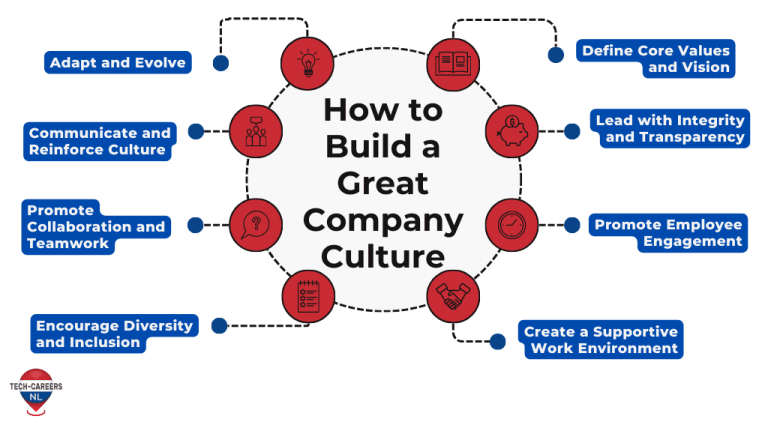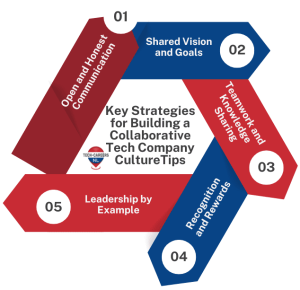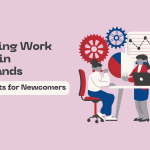
In today’s fast-paced tech industry, a strong IT team dynamics centered around collaboration is crucial for success. Emphasizing teamwork and open communication fosters innovation, enhances problem-solving capabilities, and accelerates project delivery. A collaborative environment encourages diverse perspectives and ideas, leading to more creative solutions and a more engaged workforce. As technology evolves, maintaining a culture that values cooperation and shared goals can give tech companies a competitive edge, driving both employee satisfaction and business growth.
How to Build a Great Company Culture
Building a great company environment is essential for fostering a productive and engaged workforce. But what are company culture and why is it important? At its core, the company environment encompasses the values, beliefs, and behaviors that shape how employees interact and work together. A positive work culture drives employee satisfaction, enhances performance, and ultimately contributes to business success. Here’s how you can cultivate thriving company values:
- Define Core Values and Vision: Clearly articulate the core values and vision of your company. These should reflect what your organization stands for and guide decision-making at all levels. When employees understand and align with these values, it fosters a sense of purpose and belonging. For instance, a tech company in the Netherlands might emphasize innovation, transparency, and collaboration as its core values, shaping values that drive creative problem-solving and teamwork.
- Lead with Integrity and Transparency: Leadership sets the tone for team dynamics. Leaders should model the behavior they wish to see, demonstrating integrity, honesty, and transparency. When leaders are approachable and open in their communication, it builds trust and encourages a culture of openness and mutual respect. This approach is crucial in the Netherlands, where job environment often values directness and clarity.
- Promote Employee Engagement: Engage employees by involving them in decision-making processes and recognizing their contributions. Regular feedback and opportunities for growth are essential for maintaining high levels of engagement. Recognizing achievements, whether through formal awards or informal praise, reinforces positive behaviors and motivates employees to excel.
- Create a Supportive Work Environment: A supportive work environment prioritizes employee well-being and work-life balance. Providing resources for mental health, flexible working hours, and opportunities for professional development helps create values where employees feel valued and supported. In the Netherlands, where work environment often emphasizes work-life balance, implementing these practices can significantly enhance job satisfaction and loyalty.
- Encourage Diversity and Inclusion: A diverse and inclusive workplace fosters creativity and innovation. Embrace diversity by actively recruiting from various backgrounds and ensuring that all employees feel included and respected. Training programs on diversity and inclusion can further support this goal, creating an environment where different perspectives are valued and leveraged.
- Promote Collaboration and Teamwork: Building a collaborative environment involves creating spaces and opportunities for team interaction. Encourage team projects, cross-departmental collaborations, and social activities that bring employees together. This not only enhances cooperation but also builds stronger interpersonal relationships and a sense of community.
- Communicate and Reinforce Climate: Regularly communicate the company’s culture and values through various channels such as internal newsletters, meetings, and company events. Reinforce cultural values by integrating them into everyday practices and decision-making processes. This ongoing communication helps employees understand and embrace the values, making it an integral part of their work experience.
Adapt and Evolve: The company climate is not static; it should evolve with the organization. Be open to feedback and willing to make adjustments as needed. Regularly assess the effectiveness of your values initiatives and be prepared to adapt strategies to meet the changing needs of your workforce.

By implementing these strategies, you can build and sustain a great company climate that not only attracts and retains top talent but also drives overall business success. For tech companies in the Netherlands, creating a positive and engaging work culture in Netherlands is key to achieving long-term growth and innovation, making it an essential component of your strategic approach to business.
How to Change Company Climate
Changing the office vibe is a challenging but essential endeavor for fostering a more engaged, productive, and innovative workplace. Here’s a structured approach to effectively transform your company spirit:
1. Assess the Current Climate
Before initiating change, understand the existing company climate. Conduct surveys, interviews, and focus groups to gather insights from employees at all levels. Identify the core issues and areas that need improvement, and understand how the current climate impacts employee satisfaction and performance.
2. Define the Desired Culture
Clearly articulate the climate you want to create. This involves defining new values, behaviors, and practices that align with your company’s vision and goals. For example, if you want to shift towards a more collaborative culture, emphasize values such as teamwork, open communication, and mutual respect.
3. Engage Leadership
Leadership must be fully committed to cultural change. Leaders should model the desired behaviors, communicate the vision clearly, and demonstrate a genuine commitment to the change process. Their active involvement and support are crucial for influencing others and reinforcing new cultural norms.
4. Develop a Change Strategy
Create a comprehensive plan outlining the steps and initiatives required to achieve the cultural shift. This may include revising company policies, implementing new training programs, or introducing initiatives to support the desired culture. Ensure the strategy is realistic and includes milestones for tracking progress.
5. Communicate the Change
Effective communication is key to successful cultural transformation. Clearly articulate why the change is necessary, what the new climate will look like, and how it will benefit the organization and its employees. Use multiple channels to reach all employees and address any concerns or questions they might have.
6. Implement Training and Development
Provide training and development programs to support the cultural shift. This may involve workshops on new behaviors, leadership training, and team-building activities. Tailor these programs to address the specific aspects of the culture you want to change and equip employees with the skills needed to adapt.
7. Empower Employees
Involve employees in the change process by seeking their input and encouraging them to take ownership of the transformation. Create opportunities for employees to contribute ideas and participate in initiatives that support the new atmosphere. Recognizing and rewarding those who exemplify the desired behaviors can also reinforce the change.
8. Monitor Progress and Adjust
Regularly assess the progress of your cultural change efforts. Use feedback from employees, track key metrics, and evaluate whether the changes are having the desired impact. Be prepared to make adjustments based on what’s working and what’s not. Flexibility and responsiveness are crucial for overcoming challenges and sustaining momentum.
9. Celebrate Successes
Acknowledge and celebrate milestones and successes along the way. Recognizing achievements reinforces positive behaviors and motivates employees to continue embracing the new culture. Celebrations can also serve as a powerful reminder of the progress made and the benefits of the cultural change.
10. Maintain Commitment
Changing company atmosphere is an ongoing process. Continue to reinforce the new culture through consistent communication, leadership support, and employee engagement. Ensure that the new cultural norms become embedded in everyday practices and decision-making processes.
By following these steps, you can effectively guide your organization through a cultural transformation, creating a more positive, productive, and aligned work environment.
Key Strategies for Building a Collaborative Tech Company Culture
A strong, collaborative culture is essential for a thriving tech company. Here are practical strategies to foster such an environment:
Open and Honest Communication
- Transparent Dialogue: Create channels for open and honest feedback, questions, and suggestions, which are vital for a positive work culture in an IT company.
- Active Listening: Encourage leaders and team members to actively listen to each other’s perspectives, ensuring that everyone feels heard and valued.
Shared Vision and Goals
- Clear Objectives: Define company goals clearly and communicate them effectively to all employees. This alignment is crucial in maintaining a cohesive work culture in IT companies.
- Alignment: Ensure individual and team goals contribute to the overall company vision, which is especially important for those in IT jobs in the Netherlands who seek purpose in their work.
Teamwork and Knowledge Sharing
- Cross-Functional Collaboration: Create opportunities for teams to work together on projects, leveraging diverse skill sets and fostering a collaborative work environment.
- Knowledge Transfer: Encourage knowledge sharing through mentorship, workshops, and documentation, which are key elements in building a strong work culture in IT companies.
Recognition and Rewards
- Team-Based Incentives: Implement reward systems that recognize and celebrate team achievements, promoting a culture where teamwork is valued.
- Public Acknowledgement: Publicly acknowledge and appreciate collaborative efforts, reinforcing the importance of cooperation in IT jobs in the Netherlands.
Leadership by Example
- Collaborative Behaviors: Demonstrate collaborative behaviors at all leadership levels, setting a strong example for employees to follow.
- Empathy and Support: Foster a culture of empathy and support among team members, which is essential for a healthy team ethos in IT companies.
By implementing these strategies, you can create a workplace where collaboration thrives, innovation flourishes, and employees feel valued and engaged, making your company an attractive place for those seeking IT jobs in the Netherlands.

Ready to transform your tech company’s culture?
Start implementing these strategies today to drive innovation, enhance employee engagement, and secure your position as a top employer in the industry.


 Previous Post
Previous Post Next Post
Next Post